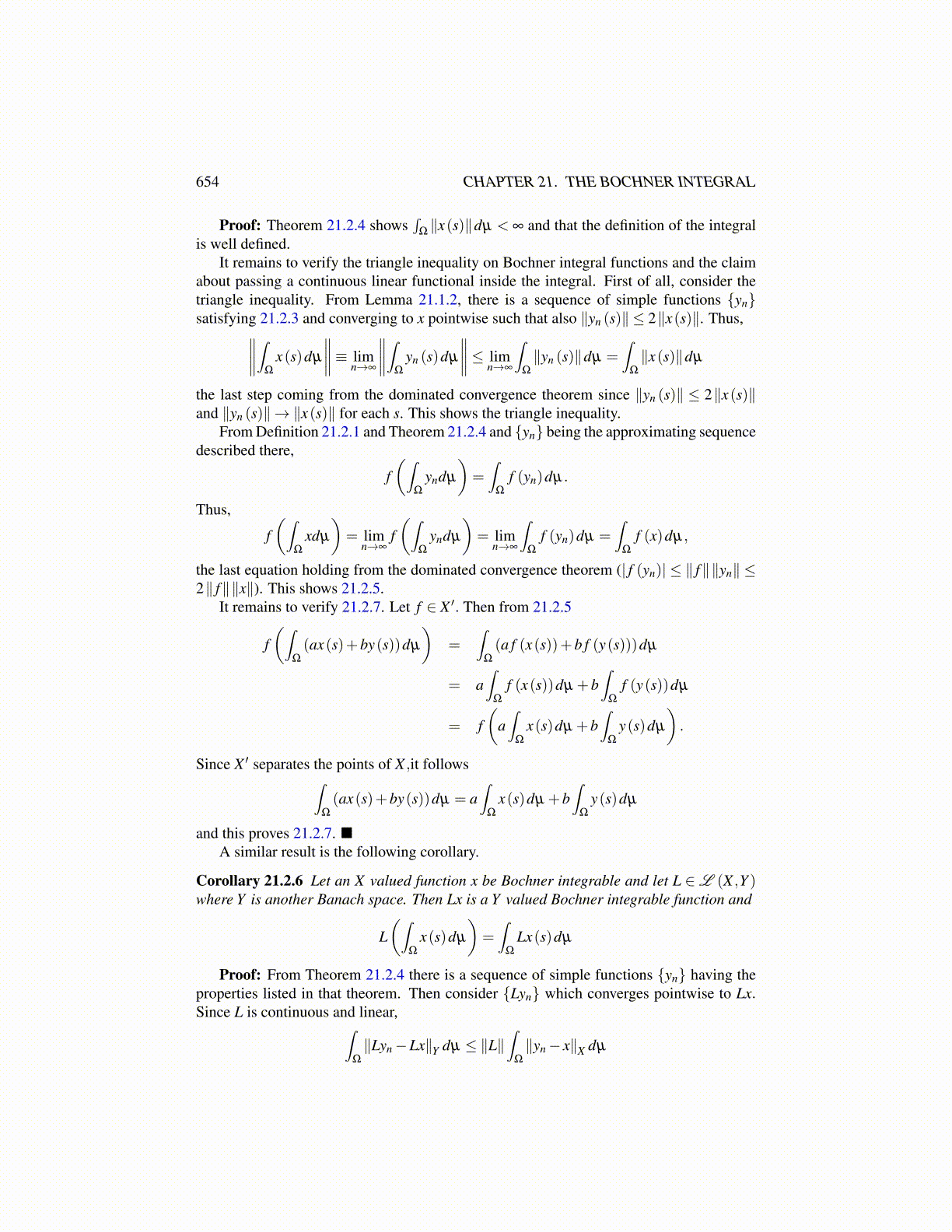
654 CHAPTER 21. THE BOCHNER INTEGRAL
Proof: Theorem 21.2.4 shows∫
Ω∥x(s)∥dµ < ∞ and that the definition of the integral
is well defined.It remains to verify the triangle inequality on Bochner integral functions and the claim
about passing a continuous linear functional inside the integral. First of all, consider thetriangle inequality. From Lemma 21.1.2, there is a sequence of simple functions {yn}satisfying 21.2.3 and converging to x pointwise such that also ∥yn (s)∥ ≤ 2∥x(s)∥. Thus,∥∥∥∥∫
Ω
x(s)dµ
∥∥∥∥≡ limn→∞
∥∥∥∥∫Ω
yn (s)dµ
∥∥∥∥≤ limn→∞
∫Ω
∥yn (s)∥dµ =∫
Ω
∥x(s)∥dµ
the last step coming from the dominated convergence theorem since ∥yn (s)∥ ≤ 2∥x(s)∥and ∥yn (s)∥→ ∥x(s)∥ for each s. This shows the triangle inequality.
From Definition 21.2.1 and Theorem 21.2.4 and {yn} being the approximating sequencedescribed there,
f(∫
Ω
yndµ
)=∫
Ω
f (yn)dµ.
Thus,
f(∫
Ω
xdµ
)= lim
n→∞f(∫
Ω
yndµ
)= lim
n→∞
∫Ω
f (yn)dµ =∫
Ω
f (x)dµ,
the last equation holding from the dominated convergence theorem (| f (yn)| ≤ ∥ f∥∥yn∥ ≤2∥ f∥∥x∥). This shows 21.2.5.
It remains to verify 21.2.7. Let f ∈ X ′. Then from 21.2.5
f(∫
Ω
(ax(s)+by(s))dµ
)=
∫Ω
(a f (x(s))+b f (y(s)))dµ
= a∫
Ω
f (x(s))dµ +b∫
Ω
f (y(s))dµ
= f(
a∫
Ω
x(s)dµ +b∫
Ω
y(s)dµ
).
Since X ′ separates the points of X ,it follows∫Ω
(ax(s)+by(s))dµ = a∫
Ω
x(s)dµ +b∫
Ω
y(s)dµ
and this proves 21.2.7.A similar result is the following corollary.
Corollary 21.2.6 Let an X valued function x be Bochner integrable and let L ∈L (X ,Y )where Y is another Banach space. Then Lx is a Y valued Bochner integrable function and
L(∫
Ω
x(s)dµ
)=∫
Ω
Lx(s)dµ
Proof: From Theorem 21.2.4 there is a sequence of simple functions {yn} having theproperties listed in that theorem. Then consider {Lyn} which converges pointwise to Lx.Since L is continuous and linear,∫
Ω
∥Lyn−Lx∥Y dµ ≤ ∥L∥∫
Ω
∥yn− x∥X dµ